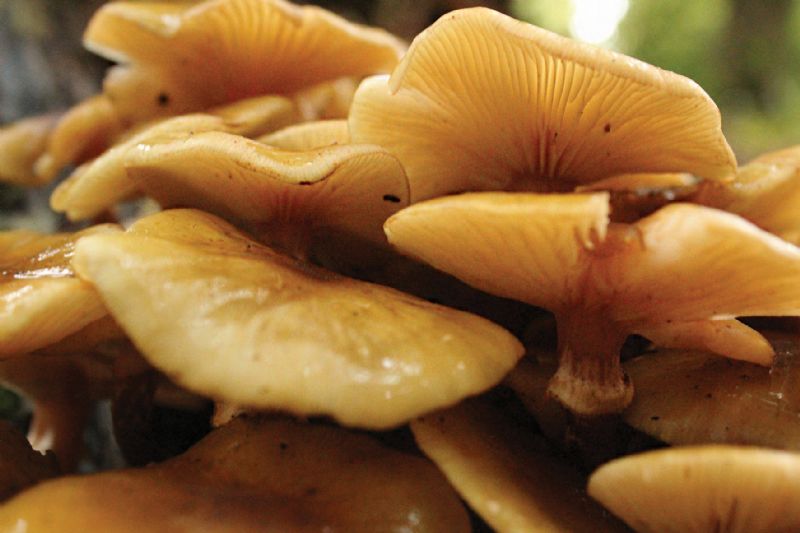- Home
- News, Articles & Reviews
We are hiring! Please click here to join our growing magazine delivery team in Gloucestershire!
Areas
Pets & Wildlife
Archive

Fungi – we’ll skip the clichéd pun
All Areas > Pets & Wildlife > Wildlife Matters
Author: Anna McQuillan, Posted: Wednesday, 24th September 2025, 09:00
One of my all-time favourite organisms is out in force at this time of year; one of the many reasons I look forward to autumn. You’ll find them up trees, in your basement, on that bread you forgot to eat. The damp, cool months have arrived, and the fungi are here for it (so is the moss I raved about in July, too!).
A mushroom is the fruiting body of a fungus rather than the whole organism. Far more extends below the surface in a network called mycelium. This can be huge – in fact, the largest organism in the world is a fungus. ‘The Humongous Fungus’ (Armillaria ostoyae) in Oregon’s Malheur National Forest covers nearly 3.7 square miles! Due to its identical genetic material across the entire network, it counts as just one individual.
Beyond the toadstool
Fungi are divided into around seven main groups, though the exact number remains debated. One group includes the toadstools and bracket fungi, which sprout like shelves from decaying wood. The ‘sac fungi’ range from prized truffles to tiny cup fungi on rotting twigs.
Another group forms crucial partnerships with plants. Other groups are less obvious but no less important: including the fast-growing moulds and microscopic water-dwelling types. Together, they reveal that fungi are far more diverse and surprising than just toadstools.
Ancient grammar
The name fungus is derived from the Latin word for mushroom. It is from here that we take the plural fungi. This is different to ‘octopus’, which is taken from the ancient Greek, so the plural is octopuses – not octopi! But I digress… let’s talk about the interesting stuff again!
I love fungi because of the beautiful variety of shapes, colours and sizes. I liken their abilities to superhero powers. Previously, I’ve hinted at Glomeromycota, a group that forms relationships with roots of plants. We call this a ‘symbiotic relationship’ where two organisms work together in a way that benefits both.
In this example, a fungus improves uptake of nitrogen or water, while the plant allows the fungi to tap into their sugar supply. Scientists are currently working on fortifying this relationship in crops to make them more robust to drought and less dependent on fertilisers.
Fungi in folklore
Fungi have fascinated story-tellers for centuries. The fly agaric – the classic red toadstool – has long been linked with witches and gnomes, and inspired scenes in Alice in Wonderland. The scarlet elf cup, or ‘fairy bath’, is rumoured to be a bathing spot for fairies when filled with dew or rain.
The charcoal-like ‘King Alfred’s Cake’ recalls the 9th-century tale of Alfred the Great who, while hiding from Viking raids and sheltering with a peasant woman, let her cakes burn – much like the blackened fungus we see today.
Proceed with caution
It’s also worth a reminder: never touch, and especially never eat, a wild mushroom unless you are absolutely certain of its identity – even then, it’s safest to admire rather than risk poisoning.
So go and have a wander, and see what fungi you can find! Try to identify them while noting their characteristics.Copyright © 2025 The Local Answer Limited.
Unauthorized use and/or duplication of this material without express and written permission from this site's author and/or owner is strictly prohibited. Excerpts and links may be used, provided that full and clear credit is given to The Local Answer Limited and thelocalanswer.co.uk with appropriate and specific direction to the original content.More articles you may be interested in...


© 2025 The Local Answer Limited - Registered in England and Wales - Company No. 06929408
Unit H, Churchill Industrial Estate, Churchill Road, Leckhampton, Cheltenham, GL53 7EG - VAT Registration No. 975613000You are leaving the TLA website...
You are now leaving the TLA website and are going to a website that is not operated by us. The Local Answer are not responsible for the content or availability of linked sites, and cannot accept liability if the linked site has been compromised and contains unsuitable images or other content. If you wish to proceed, please click the "Continue" button below:




